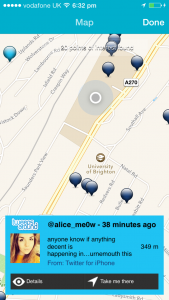Augmented reality (AR) can be described as the layering of physical space with the digital representation of space. The AR application Layer describes itself as a “digitally enhanced view of the real world, connecting you with more meaningful context in your everyday life (layar.com/augmentedreality, emphasis added). Within Layer such ‘meaningful’ content could include restaurants, cafes, shops, tourist destinations, ‘celebrity spots’ and user generated content such as photos of a location, all mapped within a digital map generated by user LBS current location. “Layar [is] based on the notion that we are constantly surrounded by location-aware digital information” (Karppi 2011:92), invisible and incalculable by the human eye but generated visually by Layar. Such technologies have extended our natural senses and capabilities (Karppi 2011), but arguably identified locations and ascribed a ‘value’ by the locational ‘marker’ (Uricchio 2011:27). The location only gains value through the digital representation (see below Kamsons Pharmacy in Layar).
If we understand AR interfaces as ‘representations of space’ it is useful to understand them as “[…] expressions of social practices carrying in them relative relations between knowledge, understanding and ideology” (Drakopoulou 2013:2). What then happens to our experience of urban space once experienced through the mediated visual AR interface? Drakopoulou argues that “the urban environment is changing not only in its appearance but in the way it is used, accessed and lived in by its inhabitants [… and] provides new ways of ‘experiencing’ the urban environment and spatial practice” (2013:1-4). AR is a temporary state of perception and sensory depiction, which Karppi (2011) argues may disrupt order and stability within our experience of urban space. It is arguable that this is achieved through a new ‘spatial commodification’ (Drakopolou 2013), enabled by AR. Personal engagement with the interface directed me, regardless of ‘functions’ to sites of consumption, from shopping, to buying groceries and eating out. Is this solely a commercial, consumer, capitalist experience, by mixing commercial information with everyday activities? Within Layar it was impossible to find a function that did not encourage or provide such commercialization of the urban environment and personalized consumption, which Drakopolou argues may encourage practices of autonomy (2013:9)?

(User generated content)
“AR applications are the next step in a long line of audiovisual technologies entangled in the networks of capitalism […] a mode of production but more broadly to heterogeneous apparatuses that affirm social subjection andtie users to machinic enslavement”
(Lazzarato 2006 in Karppi 2011:97).
Certainly from personal experience, I was not drawn to ask strangers or friends for recommendations of restaurants, locations of services or particular shops, drawn into a cycle of individualized ‘production of both reality and subjectivity’; self-subjective, self-enjoyment as a capitalist subject (Karppi 2011:100). These are arguably, not new patterns of individualized autonomy encouraged by neoliberal practices, but certainly another outlet from which to be ‘subjected’. Therefore, is there is not simply a ‘merging of physical space with digital information, ‘techno-synthetically composed’ (Drakopoulou 2013), there are broader implications, socially, culturally, and politically at play within the structures, developments and construction of an AR interface (Kennedy 2000).
This cannot however, be said in the same way of all AR applications and interfaces VisAge for example is a development project ‘visualising data from ages past’, and uses AR to visualize the spaces inside old buildings, and tells the stories of those which once lived there (http://mhms.org.uk/VisAge).
Perhaps we should consider that “the really compelling applications that are going to make AR take off just haven’t been built yet, “Instead what we’ve got primarily in the market are gimmicky advertising experiences”(Jules White, Assistant Professor of Computer Science at Vanderbilt University). With the hope that in the future this might give way to more democratic, diverse uses and forms of engagement.
Own words (333)
Bibliography
Drakopoulou, S., 2013. Pixels, bits and urban space: Observing the intersection of the space of information with urban space in augmented reality smartphone applications and peripheral vision displays. First Monday, 18(11). Available at: http://firstmonday.org/ojs/index.php/fm/ article/view/4965 [Accessed February 7, 2014].
Karppi, T. (2011) Reality Bites: Subjects of Augmented Reality Applications. In Unfolding Media Studies, eds. Puro, J. and Sihvonen, J. Turku: University of Turku: 89-102
Fidel, A. (2010) Art Gets Unmasked in the Palm of Your Hand. The New York Times.
Hill, S. 2014, March 14th. ‘Get past the gimmicks and gaze upon the future of augmented reality apps’ (http://www.digitaltrends.com/mobile/future-ar-mobile/#!Ac11h, Last Accessed: 17/03/14)
Layar Augmented Reality (Available at: http://www.layar.com/, Last Accessed 17/3/14)
Uricchio, W. 2011. ‘The algorithmic turn: photosynth, augmented reality and the changing implications of the image’, in Visual Studies, 26:1, 25-35.


